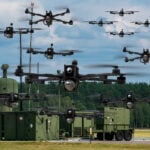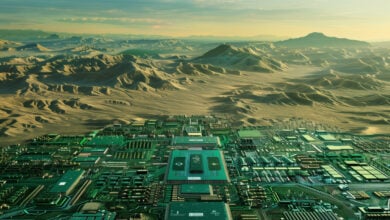AI Oasis: AI’s Role in Saudi Vision 2030

It seems everyone is talking about artificial intelligence (AI). Everyone. From senior executives to school kids, the hype – or dread – around this technology seems to be growing by the day. Much of this excitement, of course, has to do with the launch of generative AI applications like ChatGPT and Midjourney, which, for the first time perhaps, have given the average individual a felt sense of AI’s potential. That experience hasn’t just thrilled college students, designers and digital marketers, it has animated businesses and establishments across the world who are imagining an array of new commercial and public opportunities.
Not surprisingly, this explosion of interest has many questioning whether we are witnessing what may turn out to be the biggest tech bubble ever. AI research has, after all, had a long history of being the ‘next big thing’, with a boom and bust cycle seeing major peaks and troughs since the 1950s. And trends are certainly extreme enough to justify such concerns. Global AI investment has increased more than sixfold since 2016, and is forecast to approach $200 billion globally by 2025. Market interest has skyrocketed with more than 16% of companies in the Russell 3000 mentioning AI on earnings calls, up from less than just 1% of those firms in 2016. Investments in AI-driven startups have doubled between 2020 and 2021 alone, the most highly funded businesses working on machine learning and chatbots.
These types of consumer-facing applications tend to get the most press, but AI’s true potential for impact lies in facilitating systemic growth at scale. This is where private enterprise and public interests meet, and the countries leading this charge are those who have the will and capability to nurture that integration.
The Kingdom of Saudi Arabia (KSA) is a prime example, being perhaps the first country in the world to explicitly entrench AI in its national development plans. Vision 2030, the Kingdom’s long-term blueprint for economic diversification and tech-enabled sustainability, includes artificial intelligence as a crucial component of future success. Moving beyond the glossy language and investor-friendly narratives commonly found in this market, KSA sees AI as a strategic imperative, central to the nation’s hopes for accelerated social and economic evolution.
This time is different
In the 1960s, early AI researchers were full of fervor, making ambitious predictions about the timeline for achieving general AI, a form of AI that possesses human-equivalent (or better) abilities to understand, learn, and perform intellectual tasks. One of the leading voices was that of Marvin Minsky, an MIT cognitive scientist who had been present at the now-mythical 1956 Dartmouth college workshop, in which the field of AI research was born. Minsky was a central figure in the history of AI, remembered for co-founding MIT’s AI laboratory and his legendary 1967 declaration that “Within a generation […] the problem of creating ‘artificial intelligence’ will substantially be solved.”
When these proclamations did not materialize, and as the computational complexity of creation AI became clearer, funding from key sources like the U.S. government was significantly reduced. By 1974, investment in the field had declined further, beginning a 4-year downturn – an ‘AI winter’ – defined by radical reductions in support for AI research.
A resurgence of interest and funding in the early 1980s was followed by a second AI winter in 1987. Limitations of expert systems and the collapse of the Lisp machine market resulted in renewed disillusionment among VCs, governments and the broader public.
In the late 1980s and early 1990s I got my first exposure to AI in the context of a Decision Support System (DSS) development for a meat processing industry. That period was marked by AI occassionally being mentioned as a component of various buzzwords of the day – DSS, business and management expert systems, Japanese “Fifth Generation Computer Project“, and others – but constantly failing to deliver any measurable commercial benefits or excitment. Ironically, in the absence of hype, research continued faster than ever, and by 1993 investor interest was again on the rise. In 1997, reigning world chess champion Gary Kasparov was defeated by IBM’s Deep Blue, bringing some hype back. Since then, investment in AI research has grown exponentially, building up to a frenzy in recent years.
Are we in another boom riding a wave of inflated expectations? Do we have a new AI winter waiting for us just over the rise? Or are things different this time? Are we living through the age that sees AI begin to realize its long-awaited potential?
I am optimistic. Yes, there is a lot of hype about AI at the moment and the volume is increasing. And yes, much of that noise is exaggeration and hyperbole. But, we are also in a very different place from where we were in the 1970s and 1980s. Unlike those eras, the last couple decades have seen significant and tangible progress in AI development, fed by an increasingly diverse and substantial economic ecosystem.
Modern AI, especially deep learning, has demonstrated utility across a broad array of real-world applications, from image recognition to natural language processing, which weren’t feasible in previous AI eras. New GPUs and TPUs have allowed for vastly increased computational capacity, enabling researchers to train complex models that weren’t previously possible. And that training is being done in a data-rich environment that didn’t exist 30 years ago. Companies like Google, Facebook, and Tesla have capitalized by integrating AI deeply into their products and services, generating the first signs of genuine commercial value. This is in stark contrast to the earlier eras where commercial success stories were limited. Finally, AI sophistication has taken quantum leaps forward. For example, generative models, like GPT-3 or 4 (which power ChatGPT) have shown impressive capabilities in generating human-like text, images and code.
In combination, these factors allow for a new level of confidence in the future of AI and related industries. By 2030, AI could be contributing $15.7 trillion to the global economy, exceeding the current contributions of India and China combined.
The current AI boom is also characterized by a robust open-source culture, with tools like TensorFlow and PyTorch available freely. This has democratized access to AI, leading to widespread research and application. It is a border-busting shift, expanding AI development beyond ‘traditional’ epicenters like the US, China, EU and South Korea.
The Middle East is one burgeoning region in AI advancement and investment. In 2023, AI spending within the Middle East and Africa (MEA) will pass $3.0 billion, but with the expectation to grow at a phenomenal CAGR of 29.7% over the 2022–2026 period, reaching $6.4 billion in 2026.
By 2030, the Middle East is expected to accrue 2% of the global benefits of AI, equalling approximately $320 billion contribution to the region’s economies. Along with the UAE, Saudi Arabia stands to be the biggest winner, its ongoing investment in AI yielding an average annual growth in the economic contribution of AI of 31.3% between 2018 and 2030. That’s an annual contribution of US$135.2 billion in 2030, equivalent to 12.4% of GDP – only China and North America are expected to show notably higher AI impact on domestic production.
Growth by design
The rapid rise of AI’s influence in KSA’s economy is not what one would call an organic phenomenon – it is the product of strategic intent and conscious design. Initially driven by investment by the Sovereign Wealth Fund, with foreign investment expected to drive growth in the long term, Saudi Arabia’s journey towards integrating artificial intelligence as a cornerstone of its national agenda has been both deliberate and significant.
The government sent a clear signal of intent in 2019 with the establishment of the Saudi Data and Artificial Intelligence Authority (SDAIA) with the Crown Prince Mohammed bin Salman serving as its chairman. At the same day the Kingdom also established the linked National Centre for Artificial Intelligence. This central authority is responsible for organizing, developing, and overseeing all AI-related matters in the Kingdom, but it is more than a regulatory or oversight entity. SDAIA represents the country’s commitment to transition into a knowledge-based economy, and exemplifies the view that AI and data aren’t just tools but the foundational pillars driving growth, innovation, and progress.
SDAIA is tasked with strategy creation and implementation, centralizing data management (before SDAIA’s establishment, data was dispersed across multiple institutions), promoting AI & data innovations, international collaboration, and building capacity by equipping the Saudi workforce with the necessary skills and training to thrive in an AI-driven economy.
In the short time since its inception, the organization has already had a major impact. Under its guidance, the Kingdom launched the National Strategy for Data & AI (NSDAI) – a clear roadmap for AI’s integration into various sectors. SDAIA has also consolidated over 80% of government data, offering an integrated digital environment that acts as a springboard for various AI-driven innovations.
In its advocacy, education and collaboration role, SDAIA has hosted global AI summits, brokered numerous domestic and international partnerships to foster AI innovation and research, and encouraged the growth of AI startups within the Kingdom, fostering an ecosystem where these companies can thrive and contribute to the economy.
In 2022, Saudi Arabia took center stage by hosting the Global AI Summit, a gathering of global AI luminaries, including experts, scholars, and CEOs. Among other outcomes of the even discussions, a landmark $200 million deal was inked with SenseTime to establish a state-of-the-art AI lab in Saudi Arabia. Additionally, at the same event, SDAIA and Google Cloud unveiled the ‘Elevate’ initiative, aiming to empower over 25,000 women with AI and machine learning skills in the upcoming five years.
Such swift progress has been possible because of the clarity of direction in Vision 2030, a broad framework aimed at diversifying the country’s economy, reducing its dependence on oil, and developing public sectors like health, education, infrastructure, and tourism. AI is a pivotal technology in this vision, not just as a sector on its own but as a force multiplier, augmenting advancements across various domains.
Through the National Strategy for Data & AI, that vision translates into some clear targets for 2030:
- Rank among top 15 countries in AI
- Rank among top 10 countries in open data
- Create >20K data & AI specialists and experts
- Attract 75 billion SAR investments in data and AI
- Create >300 startups to enrich data and AI entrepreneurship
- Rank among top 20 countries in scientific contribution
These are not just goals, though; the Kingdom has already backed up its ambition with action and hard cash. According to reports, Saudi Arabia has bought at least 3,000 of Nvidia’s H100 chips – a $40,000 processor ostensibly designed for generative AI – in the name of King Abdullah University of Science and Technology (Kaust). These chips are a scarce commodity and, when combined with the country’s existing computational capability, will enable KSA to generate its own large language model (LLM) to rival the likes of OpenAI’s GPT models.
An integrated vision
KSA’s desire to rank in the top 15 globally for AI is not a pipe dream. This year, the country ranked 31st in the The Global Artificial Intelligence Index, but, perhaps more importantly, ranked first in the Government Strategy Index for Artificial Intelligence, one of the seven pillars of the overall ranking. Additionally, it ranked second globally in societal awareness of artificial intelligence according to the Stanford University International Index for Artificial Intelligence 2023. For a country with an economy that is relatively immature compared to more established developed nations, to rank 31st overall in AI is a respectable result, but to be the world leader in AI government strategy and societal awareness is a strong indicator that KSA’s digitally-driven approach to realizing Vision 2030 has substance.
The strategic strength of Vision 2030 is not in its bold ambitions, but rather its long term integrative view. The strategy aims to transform major sectors of society, such as education, government, healthcare and energy, and AI underpins it all.
AI-driven diagnostics, treatment recommendations, and personalized medicine can significantly enhance healthcare outcomes. Artificial intelligence can revolutionize education with personalized learning, virtual classrooms, and predictive analytics to guide student growth, while AI-oriented training and development will deliver the data and AI experts of the future.
AI can assist in monitoring environmental changes too, optimizing water usage, and predicting agricultural yields, helping Saudi address desertification, water scarcity, and food security. With Saudi’s Vision 2030 emphasizing renewable energy, AI can optimize solar and wind energy production, storage, and distribution. Indeed, in 2022 Saudi Arabia announced a deal with Google Cloud to drive various related initaitves in the first AI Center for environment, water and agriculture (AIEWA).
Beyond national borders, Saudi’s investment in AI can solidify its position as a regional tech leader, influencing technological trajectories in neighboring countries, but also set it up to become a global tech player. As KSA hosts tech events, conferences, and becomes a hub for AI innovation, its soft power – the ability to shape global perceptions and narratives about the nation – can increase. And, with dedicated AI research facilities and a favorable ecosystem, Saudi can become the Silicon Valley of the Middle East, a hotspot for tech startups and innovations.
As Saudi Arabia deeply embeds AI into its socio-economic and geopolitical fabric, it doesn’t just stand to gain technologically but holistically, touching every aspect of its national existence. This integrative understanding doesn’t only apply to different sectors and their interconnection – it’s informed by a recognition from Crown Prince Mohammed bin Salman all the way down that AI doesn’t function in isolation.
Instead, it acts as a catalyst, drawing on and amplifying the capabilities of other core technologies. In the context of Vision 2030, the interdependencies between AI and other foundational technologies like 5G, the Internet of Things (IoT), and robotics are profound. Together, they form a synergistic ecosystem that propels the nation’s digital transformation and its journey to diversification and innovation.
This integration of multiple emerging tecnologies to achieve socio-economic benefits, termed “Society 5.0”, was initially defined by the Japanese government and has gained global attention as a model for the next generation of societies. In one of my previous articles “Will the Kingdom of Saudi Arabia (KSA) beat Japan to Society 5.0?” I explore KSA’s path to Society 5.0.
Nowhere is this understanding of the need for AI-driven integration of multiple technologies more clearly articulated than in NEOM and The Line, two future-shaping projects within Vision 2030 that exemplify the principles of technological interdependence. NEOM, conceived as a global hub for trade and innovation, is expected to be powered by renewable energy and anchored in artificial intelligence for diverse tasks, from security to personalization. Such AI functionalities would lean heavily on 5G networks for rapid data exchange, while the city’s infrastructure will be embedded with Internet of Things (IoT) devices, optimizing urban operations. Additionally, robotics will drive automation in various sectors within NEOM. The CEO of NEOM, Nazmi al-Nasr, stated that NEOM and The Line will depend on the full use of artificial intelligence.
The Line, a unique linear urban development within NEOM, is designed for pedestrian prioritization but is complemented by underground, AI-driven transportation. 5G’s real-time data capabilities, IoT’s monitoring, and robotics’ service delivery fuse to make The Line an epitome of a future-ready smart city.
By embedding these technologies into the core of NEOM and The Line, Saudi Arabia is not just constructing cities but is creating adaptive, learning ecosystems. These projects exemplify how the country not only appreciates the importance of these technologies but also the intricate ways they are interconnected and how they can be harnessed to create future cities that are efficient, sustainable, and resident-centric.
Particularly commendable is the fact that in the midst of all this rapid innovation and aggresive deadlines, the Kingdom has not ignored the risk side. Cybersecurity and broader AI risk concerns are deeply embeded in Vision 2030 initiatives. See my previous article “Saudi Arabia Vision 2030: Cybersecurity at the Core of the National Transformation” for more on this. Just a few weeks ago, the Crown Prince has approved the establishment of the International Center for Artificial Intelligence Research and Ethics in Riyadh.
In a country that so highly prizes tradition, it is refreshing to see such progressive thinking translated into action. Vision 2030 has always been ambitious and, as with any grand vision, has always run the risk of remaining just that: a vision, an idea of what the future may be. But in KSA’s approach to AI we see practical, measurable progress at a world-leading pace. For someone who believes in the potential of technologies like AI to help shape a healthier future for all, that’s exciting to see.
For 30+ years, I've been committed to protecting people, businesses, and the environment from the physical harm caused by cyber-kinetic threats, blending cybersecurity strategies and resilience and safety measures. Lately, my worries have grown due to the rapid, complex advancements in Artificial Intelligence (AI). Having observed AI's progression for two decades and penned a book on its future, I see it as a unique and escalating threat, especially when applied to military systems, disinformation, or integrated into critical infrastructure like 5G networks or smart grids. More about me, and about Defence.AI.











































